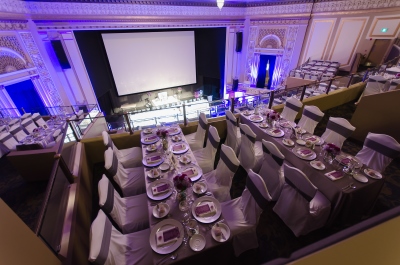Metropolitan Theatre National Historic Site of Canada
Winnipeg, Manitoba

Interior view
© Courtesy of Canad Inns | Courtoisie du Canad Inns, 2016.
Address :
281-285 Donald Street, Winnipeg, Manitoba
Recognition Statute:
Historic Sites and Monuments Act (R.S.C., 1985, c. H-4)
Designation Date:
1991-06-10
Dates:
-
1919 to 1919
(Construction)
Event, Person, Organization:
-
C. Howard Crane
(Architect)
-
Thomas Lamb
(Architect)
Other Name(s):
-
Metropolitan Theatre
(Designation Name)
-
Allen Theatre
(Other Name)
Plaque(s)
This Winnipeg landmark opened as the Allen Theatre in 1920. It is one of the few surviving cinemas from when the Allen brothers were Canada’s leading movie theatre operators and film distributors. The Allens’ fierce American rival, Famous Players, bought the theatre in 1923 and renamed it the Metropolitan. In an era when purpose-built cinemas and the film industry itself were relatively new, this was one of the first great movie palaces. Prominent American theatre architect C. Howard Crane’s design showcased striking exterior details and opulent interior decor, including comfortable lounge areas and seating for more than 2,000 people.
Description of Historic Place
The Metropolitan Theatre at Winnipeg is an early-20th-century movie theatre. It is located in the heart of downtown Winnipeg. The formal recognition consists of the building on its legal property at the time of designation.
Heritage Value
The Metropolitan Theatre was designated a national historic site in 1991 because: it is a fine example of the work of prominent American theatre architect C. Howard Crane; it represents the cultural impact of the movie theatre in the 1920s; and it is associated with the corporate struggle between the Allen and Famous Players Theatre chains for supremacy in the film distribution industry in Canada.
The Metropolitan is one of three surviving Canadian examples of Crane’s work, and a good example of an early phase of his international work. Its exterior facade typifies cinemas designed by Crane for the Allen theatre chain. The interior, modified in the 1930s, is representative of the work of theatre designer Emmanuel Briffa.
During the early 20th century, the Allen family ran the biggest cinema chain in Canada, and one of the largest in the world. The Metropolitan, originally called the Allen, is one of four surviving movie theatres in Canada built by the Allen brothers, Jay and Jule, and their father, Bernard. One of the first of the large, opulent “movie palaces” built in Canada, the Metropolitan represents the impact of the Allen cinema chain on Canadian life and its contribution to the Canadian film industry. By promoting movies and moviegoing, and by erecting large, opulent movie palaces across the country, the Allen family helped to elevate movies to a form of reputable, accessible and affordable entertainment. The Allens were strong promoters of Canadian content.
In Winnipeg, the Metropolitan was built on the same street with a now-demolished Famous Players theatre of comparable size and opulence, whose construction signalled the beginning of a battle for supremacy between the Allen and Famous Players cinema chains. The Metropolitan represents the intense competition between the two chains during the early 1920s, which led to flamboyant promotions, greater movie attendance, and the construction of similarly paired Allen and Famous Players theatres in other Canadian cities. The competition ended with collapse of the Allen empire in 1923 and the acquisition of many of its theatres, including the Metropolitan, by Famous Players.
Source: Historic Sites and Monuments Board of Canada, Minutes, 1991.
Character-Defining Elements
The key elements that relate to the heritage value of the Metropolitan Theatre include, for example: its elaborate exterior facade, typical of Crane-designed and Allen-owned theatres, including: remnants of the central entrance with exterior box office; a vertical theatre sign above; a series of large, round-headed windows at the second-storey level; a substantial cornice and parapet; wrought- iron, faux balconies at the windows; brick walls with pilasters and carved stone inserts; its interior functional design, typical of Crane-designed and Allen-owned theatres, including: a semi-circular seating arrangement with one, gently sloped, cantilevered balcony; small, sidewall boxes; modified versions of a stage and orchestra pit; a high, domed ceiling; spacious lounges, including the main lobby and the mezzanine promenade; and twin staircases between lobby and mezzanine; interior decorative treatments designed by Emmanuel Briffa, particularly plasterwork on the ceilings and walls of the auditorium, balcony and mezzanine, and along the front of the balcony; original flooring, lighting and fire curtains; its large size, accommodating more than 2000 seats.